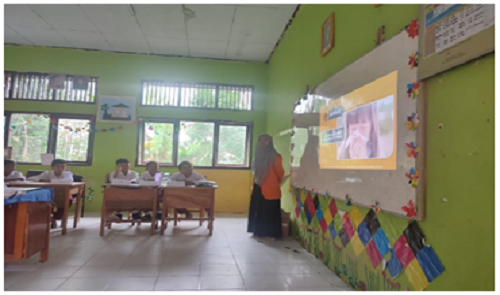
Application of The Discovery Learning Model with a Thinking Approach to Improving Students' Activity on The Content Indonesian Language in Class III
Abstract
Keywords
Full Text:
PDFReferences
Ali, M. (2020). Learning Indonesian Language and Literature (BASASTRA) in Elementary Schools. PERNIK: Journal of Early Childhood Education, 3(1), 35-44.
Baharuddin, & Wahyuni, EN (2015). Learning & Learning Theory. Yogyakarta: AR-RUZZ MEDIA
Faizah, SN (2017). The Nature of Learning and Learning. Journal of Madrasah Ibtidaiyah Teacher Education, 1(2), 175-185.
Farrohman, O. (2017). Implementation of Indonesian Language Learning in Elementary/MI. Primary: Journal of Basic Science and Education, 9(1), 24-34.
Fitrah, A., Yantoro, & Hayati, S. (2022). Teacher Strategies in Active Learning Through a Scientific Approach in Realizing 21st Century Learning. Basicedu Journal, 6(2), 2943-2952.
Handita, Y., Prasetyo, PW, & Sugiyem. (2022). Application of the Discovery Learning Model to Increase Student Learning Activeness During the Pandemic. Journal of Derivatives, 9(1), 82 – 94.
Luthfi, MR, Huda, C., & Susanto, J. (2021). Application of the Discovery Learning Learning Model to Increase Student Learning Activeness in Class V Thematic Learning, Theme 8 at SD Negeri 1 Selo, Grobogan Regency, Central Java. Journal of Pedagogy, 8(3), 422-430.
Mukaramah, M., Kustina, R., & Rismawati. (2020). Analyzing the Advantages and Disadvantages of the Audio-Visual Based Discovery Learning Model in Indonesian Language Lessons. Educational Student Scientific Journal, 1(1).
Naziah, ST, Maula, LH, & Sutisnawati, A. (2020). Analysis of Student Learning Activeness During Online Learning During the Covid-19 Period in Elementary Schools. JPSD Journal, 7(2), 109-120.
Nurhayati, E. (2020). Increasing Student Activeness in Online Learning Through the Educational Game Media Quiziz During the Period of Preventing the Spread of Covid-19. Journal of Pedagogy, 7(3), 145-150.
Oktarina, A., Naimah, & Heldanita. (2021). Student Learning Activeness through the MIKiR Concept in the Preschool Learning Design Course in the Covid-19 Pandemic Era. Kindergarten: Journal of Islamic Early Childhood Education, 4(2), 131-144.
Pahleviannur, MR, Mudrikah, S., Mulyono, H., Bano, VO, Rizqi, M., Syahrul, M., . . . Hidayati. (2022). Classroom action research. Sukoharjo: PRADINA LIBRARY.
Panggabean, S. (2021). The concept of Student Center Learning and Teacher Learning. Bandung: Indonesian Science Media.
Regulation of the Minister of Education, Culture, Research and Technology concerning Process Standards for Early Childhood Education, Basic Education Levels and Secondary Education Levels.
Pernantah, PS (2019). Active Learning Scenario Design Using the "MIKIR" Method in Social Sciences Education Courses. Indonesian Journal of Social Science Education, 1(2), 145-155.
Prasetyo, AD, & Abduh, M. (2021). Increasing Learning Activeness Through the Discovery Learning Model in Elementary Schools. Basicedu Journal, 5(4), 1717-1724.
Raehang. (2014). Active Learning as the Parent of Cooperative Learning. Al-Ta'dib Journal, 7(1), 149-167.
Rahayu, IP, & Hardini, AT (2019). Application of the Discovery Learning Model to Increase Activeness and Thematic Learning Outcomes. Journal of Educational Action Research, 3(3), 193-200.
Rokhanah, N., Widowati, A., & Sutanto, EH (2021). Increasing Student Learning Activeness by Implementing the Student Team Achievement Divisions (STAD) Cooperative Learning Model. Journal of Educational Sciences, 3(5), 3173-3180.
Simanjuntak, K., & Siregar, RS (2022). Students' Cognitive Development and Implementation in Learning Activities. Journal of Islamic Education, 1(1), 111-124.
Siregar, EF, & Sari, SP (2020). Optimizing the MIKIR Approach as a 21st Century Learning Solution for Muhammadiyah Elementary School Teachers in Medan City. Journal of Community Service, 4(3), 550-556.
Suhandi, A., Pamela, IS, Mubarok, MA, Amri, K., & Oktavia, A. (2021). The Validation of the Development of MIKIR-based Student Worksheets on the Theme "Always Saving Energy" among the Fourth Graders of Elementary School. Scientific Journal of Basic Education, 7(1), 71-84.
Sumianingrum, NE, Wibawanto, H., & Haryono. (20117). effectiveness of the E-Learning Assisted Discovery Learning Method at SMA Negeri 1 Jepara. Innovative Journal of Curriculum and Educational Technology, 6(1), 27-35.
Tanoto Foundation. (2019). Become an Inspirational Teacher with the MIKIR Tanoto Foundation Concept.
Tumurun, SW, Gusrayani, D., & Jayadinata, AK (2016). The Influence of the Discovery Learning Learning Model on Students' Creative Thinking Skills on the Material Properties of Light. Journal of Scientific Pens, 1(1), 101-110.
Wibowo, N. (2016). Efforts to increase student activity through learning based on learning styles at SMK Negeri 1 Saptosari. Journal of Electronics, Informatics, and Vocational Education (ELINVO), 1(2), 128-139.
Yantoro. (2020). Analysis Of Teacher's Ability In Applying MIKIR Elements In Active Learning At High Classes In The Primary School. PAJAR (Education and Teaching) Journal, 4(2), 356-366.
DOI: http://dx.doi.org/10.31258/jes.7.4.p.622-635
Refbacks
Copyright (c) 2023 Nurhidayana Sihite

This work is licensed under a Creative Commons Attribution 4.0 International License.
Publisher: FKIP Universitas Riau












